外研版(2019)必修二 Unit 6 Earth first Using Language课件(共23张PPT,内镶嵌音频)
文档属性
| 名称 | 外研版(2019)必修二 Unit 6 Earth first Using Language课件(共23张PPT,内镶嵌音频) | 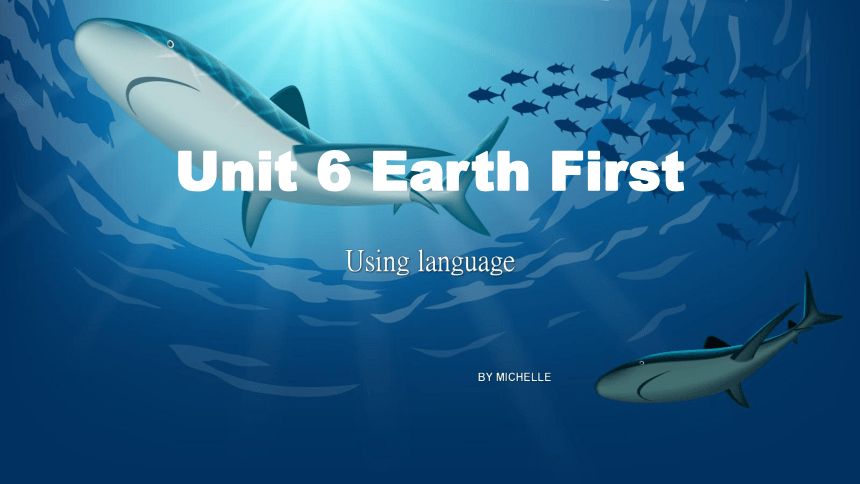 | |
| 格式 | pptx | ||
| 文件大小 | 16.7MB | ||
| 资源类型 | 教案 | ||
| 版本资源 | 外研版(2019) | ||
| 科目 | 英语 | ||
| 更新时间 | 2025-01-10 13:43:51 | ||
图片预览

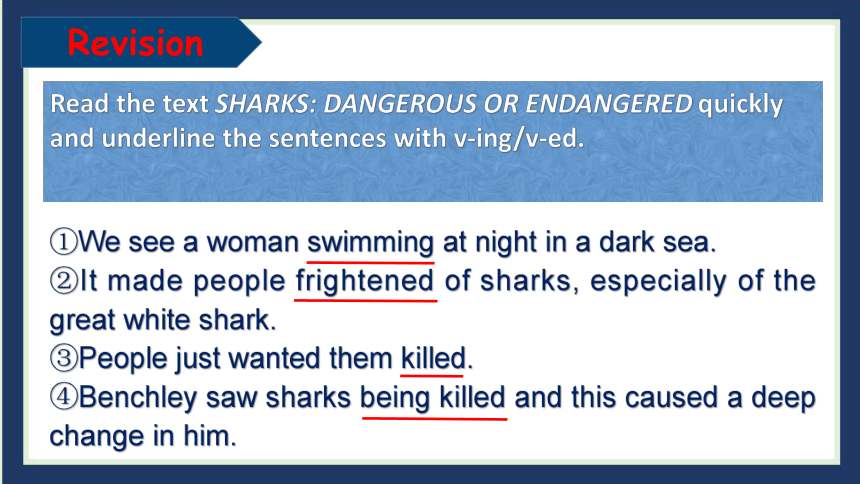
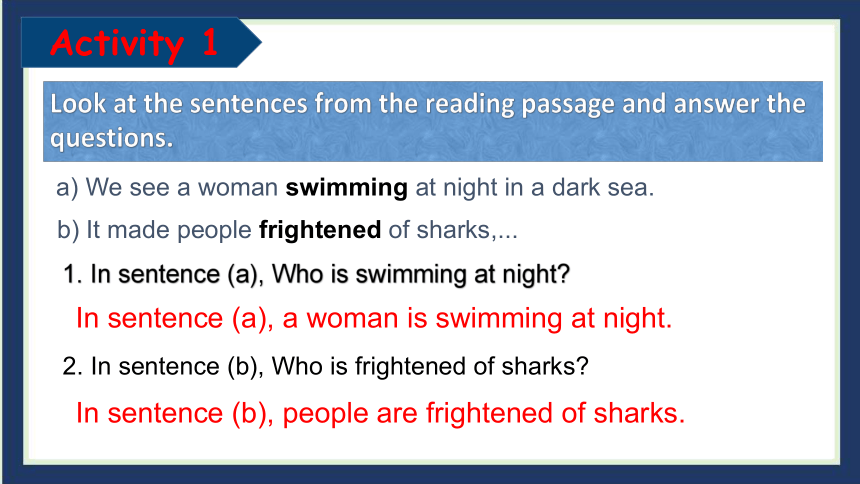
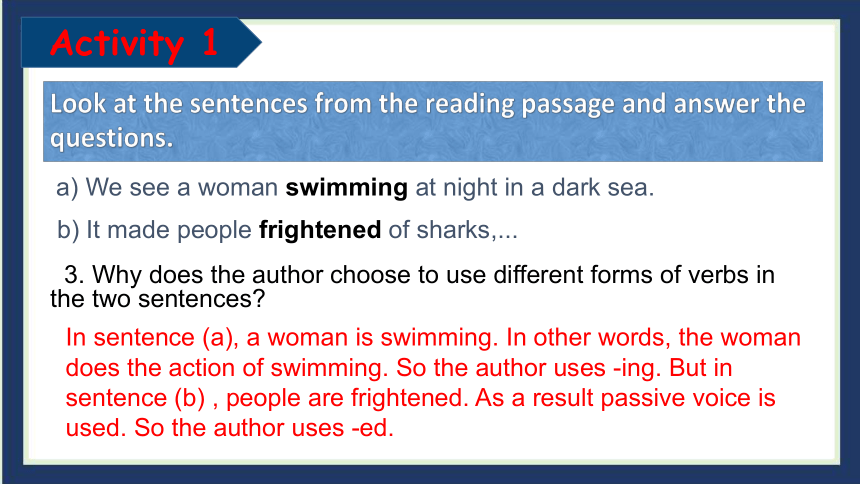
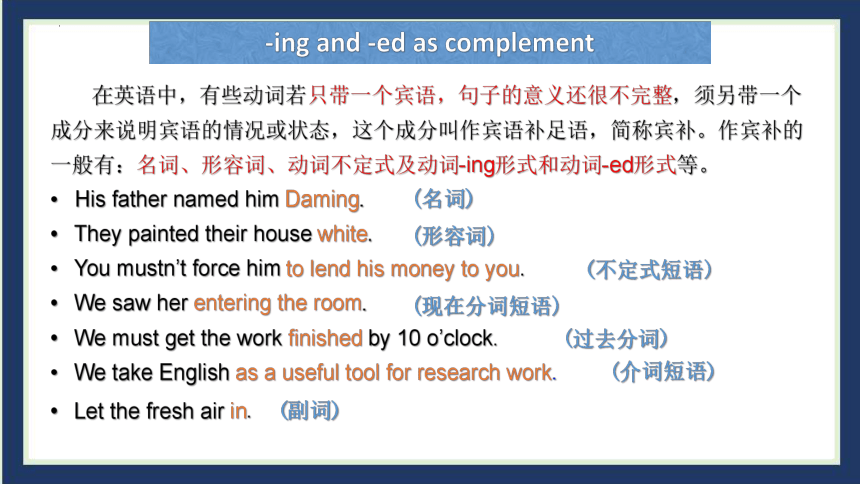
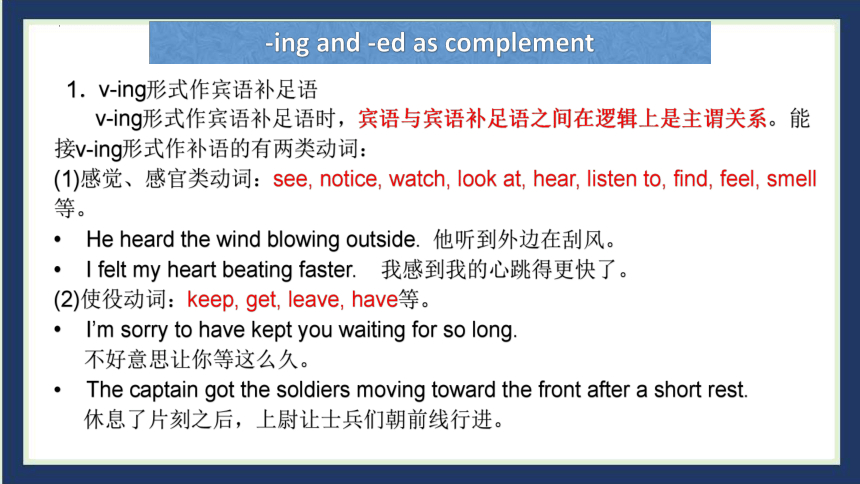
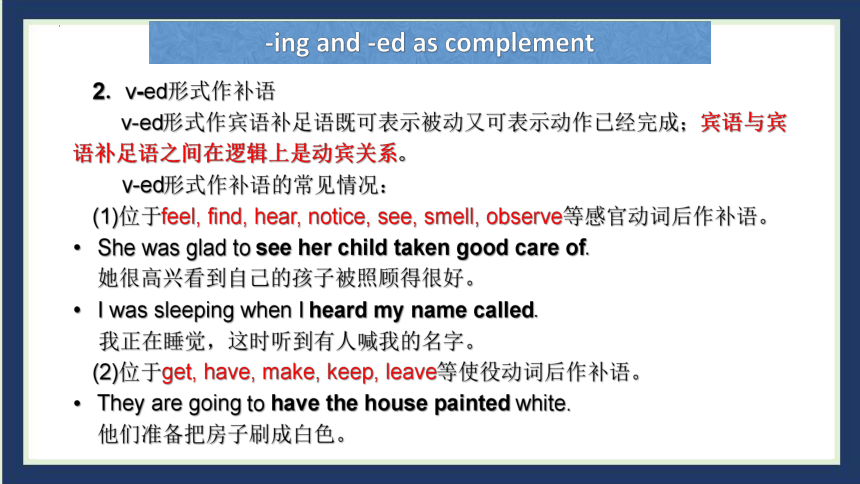
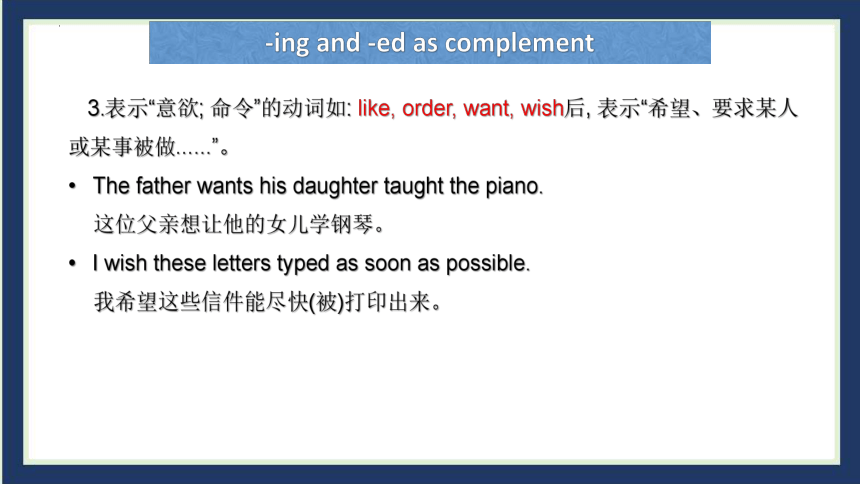
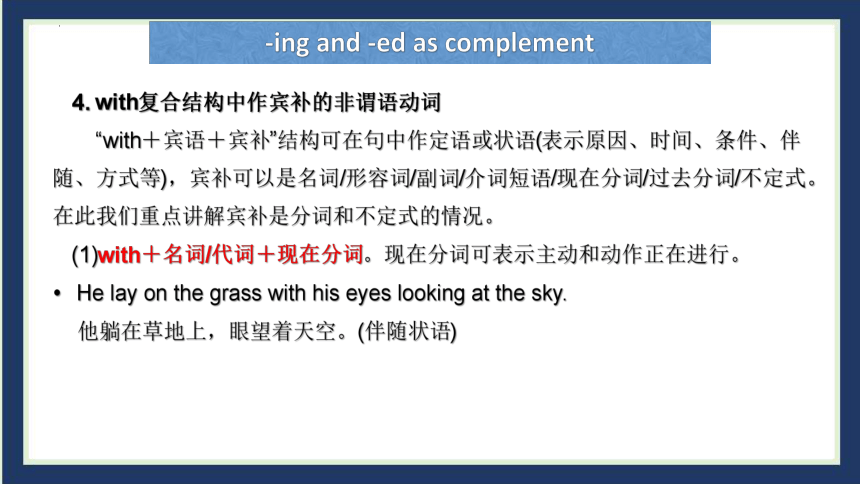
文档简介
(共23张PPT)
Unit 6 Earth First
Using language
BY MICHELLE
Read the text SHARKS: DANGEROUS OR ENDANGERED quickly and underline the sentences with v-ing/v-ed.
①We see a woman swimming at night in a dark sea.
②It made people frightened of sharks, especially of the great white shark.
③People just wanted them killed.
④Benchley saw sharks being killed and this caused a deep change in him.
Revision
a) We see a woman swimming at night in a dark sea.
b) It made people frightened of sharks,...
1. In sentence (a), Who is swimming at night
2. In sentence (b), Who is frightened of sharks
In sentence (a), a woman is swimming at night.
In sentence (b), people are frightened of sharks.
Activity 1
Look at the sentences from the reading passage and answer the questions.
a) We see a woman swimming at night in a dark sea.
b) It made people frightened of sharks,...
3. Why does the author choose to use different forms of verbs in the two sentences
Activity 1
Look at the sentences from the reading passage and answer the questions.
In sentence (a), a woman is swimming. In other words, the woman does the action of swimming. So the author uses -ing. But in sentence (b) , people are frightened. As a result passive voice is used. So the author uses -ed.
-ing and -ed as complement
在英语中,有些动词若只带一个宾语,句子的意义还很不完整,须另带一个成分来说明宾语的情况或状态,这个成分叫作宾语补足语,简称宾补。作宾补的一般有:名词、形容词、动词不定式及动词-ing形式和动词-ed形式等。
His father named him Daming.
They painted their house white.
You mustn’t force him to lend his money to you.
We saw her entering the room.
We must get the work finished by 10 o’clock.
We take English as a useful tool for research work.
Let the fresh air in.
(名词)
(形容词)
(不定式短语)
(现在分词短语)
(过去分词)
(介词短语)
(副词)
-ing and -ed as complement
1.v ing形式作宾语补足语
v ing形式作宾语补足语时,宾语与宾语补足语之间在逻辑上是主谓关系。能接v ing形式作补语的有两类动词:
(1)感觉、感官类动词:see, notice, watch, look at, hear, listen to, find, feel, smell等。
He heard the wind blowing outside. 他听到外边在刮风。
I felt my heart beating faster. 我感到我的心跳得更快了。
(2)使役动词:keep, get, leave, have等。
I’m sorry to have kept you waiting for so long.
不好意思让你等这么久。
The captain got the soldiers moving toward the front after a short rest.
休息了片刻之后,上尉让士兵们朝前线行进。
-ing and -ed as complement
2.v ed形式作补语
v ed形式作宾语补足语既可表示被动又可表示动作已经完成;宾语与宾语补足语之间在逻辑上是动宾关系。
v ed形式作补语的常见情况:
(1)位于feel, find, hear, notice, see, smell, observe等感官动词后作补语。
She was glad to see her child taken good care of.
她很高兴看到自己的孩子被照顾得很好。
I was sleeping when I heard my name called.
我正在睡觉,这时听到有人喊我的名字。
(2)位于get, have, make, keep, leave等使役动词后作补语。
They are going to have the house painted white.
他们准备把房子刷成白色。
-ing and -ed as complement
3.表示“意欲; 命令”的动词如: like, order, want, wish后, 表示“希望、要求某人或某事被做......”。
The father wants his daughter taught the piano.
这位父亲想让他的女儿学钢琴。
I wish these letters typed as soon as possible.
我希望这些信件能尽快(被)打印出来。
-ing and -ed as complement
4. with复合结构中作宾补的非谓语动词
“with+宾语+宾补”结构可在句中作定语或状语(表示原因、时间、条件、伴随、方式等),宾补可以是名词/形容词/副词/介词短语/现在分词/过去分词/不定式。 在此我们重点讲解宾补是分词和不定式的情况。
(1)with+名词/代词+现在分词。现在分词可表示主动和动作正在进行。
He lay on the grass with his eyes looking at the sky.
他躺在草地上,眼望着天空。(伴随状语)
-ing and -ed as complement
(2)with+名词/代词+过去分词。过去分词可表示被动和动作已完成。
With his hair cut, he looked much younger.
理了发,他看起来年轻多了。(原因状语)
(3)with+名词/代词+不定式。不定式表示动作尚未发生。
切记:不定式一般情况下都用主动形式。
With a lot of homework to do, I can’t go skating with you.
因为有很多家庭作业要做,我不能和你一起去滑冰了。(原因状语)
单句语法填空
1.When I passed by his office, I heard him _______(sing) a Chinese song.
2.The place looks much better since they had it ____________(redecorate).
3.Tom has been away from home for two years, leaving his room _________ (cover) with dust.
4.When I saw the dog ____________(beat) by several boys, I came up to stop them.
5.The man left us __________(stand) alone, unable to find any help.
6.When the Greens found their house__________(break) into, they called the police at once.
7.Did you hear the song _______(sing) in Chinese when in the U.S.A.
8.When I was on my way to school this morning, I saw two women ________ (argue).
singing
redeorated
covered
being beaten
standing
broken
sung
arguing
Attracted / Attracting by mermaids since she was a child, Hannah Fraser created her first tail when she was only nine years old. Now, she is a model and performance artist devoted / devoting to ocean conservation. She can be seen worn / wearing mermaid clothing and dived / diving up to 50 feet underwater to swim with dolphins, sharks and whales. She appeared in The Cove, a documentary aiming at highlighting the cruelty of dolphin hunting. Besides performing and modelling, Hannah travels the world given / giving presentations and talks, getting more people involved / involving in the conservation of ocean life.
Activity 2
Read the passage about mermaids and choose the correct form of the verbs.
Activity 3
Rewrite the underlined sentences.
Sanjiangyuan National Nature Reserve
Here, you can see dramatic landscapes changing from mountains to grasslands, forests to rivers.
Activity 3
Rewrite the underlined sentences.
In recent years, we have seen large areas of wetland damaged by human activity.
This includes keeping the original environment untouched, …
Activity 4
Dealing with global warming
water conservation
LED bulb
renewable energy
carbon footprint
greenhouse effect
reusable water bottle
Share what you know about these expressions.
Activity 5
Complete the brochure with expressions in Activity 4.
reusable water bottle
carbon footprint
renewable energy
LED bulb
Water conservation
greenhouse effect
Activity 6
Discuss what you can do to help deal with global warming, using the words and expressions you have learnt.
A: I will go to school by bike to reduce my carbon footprint.
B: I will bring a reusable bag when I go shopping.
...
Smog comes from the words “smoke” and “fog”,and it is used to describe the air pollution in cities caused mainly by traffic and factories. Smog can be dangerous because it causes severe breathing problems and infections.
Did You Know
Environmental problems to be solved
Activity 7
Listen to the lecture and choose the topics that are covered.
1. What the word “smog” means.
2. When the word “smog” appeared.
3. What caused smog in the past.
4. What causes smog now.
5. The effects of smog on the environment.
6. How governments try to reduce smog.
7. What will happen if we don't reduce smog.
√
√
√
√
√
Activity 8
Listen again and complete the slides.
1900s
The Great Smog
no wind
chemicals coming from traffic
chemicals
requirements of paying to drive
Now talk about what the students say to interrupt the lecturer politely.
Activity 9-10
Work in pairs and talk about recycling.
Student A: Turn to Page 84.
Student B: Turn to Page 87.
Work in pairs. Talk about another environmental problem and have a similar conversation.
Ss to talk about another environmental problem and have a similar conversation.
Remember the functions of v-ing and v-ed.
Complete the exercises.
Homework
Show your love and care to wildlife!
THANKS FOR WATCHING
Unit 6 Earth First
Using language
BY MICHELLE
Read the text SHARKS: DANGEROUS OR ENDANGERED quickly and underline the sentences with v-ing/v-ed.
①We see a woman swimming at night in a dark sea.
②It made people frightened of sharks, especially of the great white shark.
③People just wanted them killed.
④Benchley saw sharks being killed and this caused a deep change in him.
Revision
a) We see a woman swimming at night in a dark sea.
b) It made people frightened of sharks,...
1. In sentence (a), Who is swimming at night
2. In sentence (b), Who is frightened of sharks
In sentence (a), a woman is swimming at night.
In sentence (b), people are frightened of sharks.
Activity 1
Look at the sentences from the reading passage and answer the questions.
a) We see a woman swimming at night in a dark sea.
b) It made people frightened of sharks,...
3. Why does the author choose to use different forms of verbs in the two sentences
Activity 1
Look at the sentences from the reading passage and answer the questions.
In sentence (a), a woman is swimming. In other words, the woman does the action of swimming. So the author uses -ing. But in sentence (b) , people are frightened. As a result passive voice is used. So the author uses -ed.
-ing and -ed as complement
在英语中,有些动词若只带一个宾语,句子的意义还很不完整,须另带一个成分来说明宾语的情况或状态,这个成分叫作宾语补足语,简称宾补。作宾补的一般有:名词、形容词、动词不定式及动词-ing形式和动词-ed形式等。
His father named him Daming.
They painted their house white.
You mustn’t force him to lend his money to you.
We saw her entering the room.
We must get the work finished by 10 o’clock.
We take English as a useful tool for research work.
Let the fresh air in.
(名词)
(形容词)
(不定式短语)
(现在分词短语)
(过去分词)
(介词短语)
(副词)
-ing and -ed as complement
1.v ing形式作宾语补足语
v ing形式作宾语补足语时,宾语与宾语补足语之间在逻辑上是主谓关系。能接v ing形式作补语的有两类动词:
(1)感觉、感官类动词:see, notice, watch, look at, hear, listen to, find, feel, smell等。
He heard the wind blowing outside. 他听到外边在刮风。
I felt my heart beating faster. 我感到我的心跳得更快了。
(2)使役动词:keep, get, leave, have等。
I’m sorry to have kept you waiting for so long.
不好意思让你等这么久。
The captain got the soldiers moving toward the front after a short rest.
休息了片刻之后,上尉让士兵们朝前线行进。
-ing and -ed as complement
2.v ed形式作补语
v ed形式作宾语补足语既可表示被动又可表示动作已经完成;宾语与宾语补足语之间在逻辑上是动宾关系。
v ed形式作补语的常见情况:
(1)位于feel, find, hear, notice, see, smell, observe等感官动词后作补语。
She was glad to see her child taken good care of.
她很高兴看到自己的孩子被照顾得很好。
I was sleeping when I heard my name called.
我正在睡觉,这时听到有人喊我的名字。
(2)位于get, have, make, keep, leave等使役动词后作补语。
They are going to have the house painted white.
他们准备把房子刷成白色。
-ing and -ed as complement
3.表示“意欲; 命令”的动词如: like, order, want, wish后, 表示“希望、要求某人或某事被做......”。
The father wants his daughter taught the piano.
这位父亲想让他的女儿学钢琴。
I wish these letters typed as soon as possible.
我希望这些信件能尽快(被)打印出来。
-ing and -ed as complement
4. with复合结构中作宾补的非谓语动词
“with+宾语+宾补”结构可在句中作定语或状语(表示原因、时间、条件、伴随、方式等),宾补可以是名词/形容词/副词/介词短语/现在分词/过去分词/不定式。 在此我们重点讲解宾补是分词和不定式的情况。
(1)with+名词/代词+现在分词。现在分词可表示主动和动作正在进行。
He lay on the grass with his eyes looking at the sky.
他躺在草地上,眼望着天空。(伴随状语)
-ing and -ed as complement
(2)with+名词/代词+过去分词。过去分词可表示被动和动作已完成。
With his hair cut, he looked much younger.
理了发,他看起来年轻多了。(原因状语)
(3)with+名词/代词+不定式。不定式表示动作尚未发生。
切记:不定式一般情况下都用主动形式。
With a lot of homework to do, I can’t go skating with you.
因为有很多家庭作业要做,我不能和你一起去滑冰了。(原因状语)
单句语法填空
1.When I passed by his office, I heard him _______(sing) a Chinese song.
2.The place looks much better since they had it ____________(redecorate).
3.Tom has been away from home for two years, leaving his room _________ (cover) with dust.
4.When I saw the dog ____________(beat) by several boys, I came up to stop them.
5.The man left us __________(stand) alone, unable to find any help.
6.When the Greens found their house__________(break) into, they called the police at once.
7.Did you hear the song _______(sing) in Chinese when in the U.S.A.
8.When I was on my way to school this morning, I saw two women ________ (argue).
singing
redeorated
covered
being beaten
standing
broken
sung
arguing
Attracted / Attracting by mermaids since she was a child, Hannah Fraser created her first tail when she was only nine years old. Now, she is a model and performance artist devoted / devoting to ocean conservation. She can be seen worn / wearing mermaid clothing and dived / diving up to 50 feet underwater to swim with dolphins, sharks and whales. She appeared in The Cove, a documentary aiming at highlighting the cruelty of dolphin hunting. Besides performing and modelling, Hannah travels the world given / giving presentations and talks, getting more people involved / involving in the conservation of ocean life.
Activity 2
Read the passage about mermaids and choose the correct form of the verbs.
Activity 3
Rewrite the underlined sentences.
Sanjiangyuan National Nature Reserve
Here, you can see dramatic landscapes changing from mountains to grasslands, forests to rivers.
Activity 3
Rewrite the underlined sentences.
In recent years, we have seen large areas of wetland damaged by human activity.
This includes keeping the original environment untouched, …
Activity 4
Dealing with global warming
water conservation
LED bulb
renewable energy
carbon footprint
greenhouse effect
reusable water bottle
Share what you know about these expressions.
Activity 5
Complete the brochure with expressions in Activity 4.
reusable water bottle
carbon footprint
renewable energy
LED bulb
Water conservation
greenhouse effect
Activity 6
Discuss what you can do to help deal with global warming, using the words and expressions you have learnt.
A: I will go to school by bike to reduce my carbon footprint.
B: I will bring a reusable bag when I go shopping.
...
Smog comes from the words “smoke” and “fog”,and it is used to describe the air pollution in cities caused mainly by traffic and factories. Smog can be dangerous because it causes severe breathing problems and infections.
Did You Know
Environmental problems to be solved
Activity 7
Listen to the lecture and choose the topics that are covered.
1. What the word “smog” means.
2. When the word “smog” appeared.
3. What caused smog in the past.
4. What causes smog now.
5. The effects of smog on the environment.
6. How governments try to reduce smog.
7. What will happen if we don't reduce smog.
√
√
√
√
√
Activity 8
Listen again and complete the slides.
1900s
The Great Smog
no wind
chemicals coming from traffic
chemicals
requirements of paying to drive
Now talk about what the students say to interrupt the lecturer politely.
Activity 9-10
Work in pairs and talk about recycling.
Student A: Turn to Page 84.
Student B: Turn to Page 87.
Work in pairs. Talk about another environmental problem and have a similar conversation.
Ss to talk about another environmental problem and have a similar conversation.
Remember the functions of v-ing and v-ed.
Complete the exercises.
Homework
Show your love and care to wildlife!
THANKS FOR WATCHING
